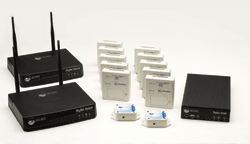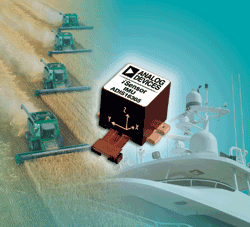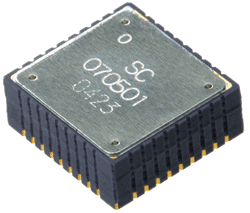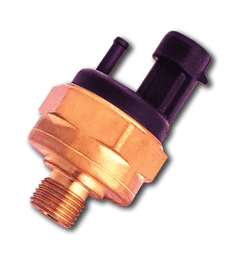Many products supporting wireless sensor networks and low-power, energy-harvesting apps were at this year’s Sensor Expo
BY RICHARD COMERFORD
If there was one thing that this year’s Sensors Expo made clear, it is that wireless sensor networks (WSNs) have arrived. Not only were more than half the technical session at the June meeting in Rosemont, IL, devoted to discussions about WSNs or their impact on measurement, control, and sensing, but the exhibit hall was awash with products related to their design and implementation.
Wireless IP networks
Arch Rock (www.archrock.com) was recognized with a “Best of Sensors Expo” award in the Communications and Networking category for its PhyNet WSN (see Fig. 1 ), which addresses large-scale enterprise applications by forming large, resilient IP-based WSNs that are integrated into the enterprise IP infrastructure (see Electronic Products , http://www2.electronicproducts.com/Wireless_sensor_network_snaps_into_existing_IP_infrastructure-article-hlrc04_may2008-html.aspx).

Fig. 1. The PhyNet wirelss sensor network brings wireless sensing into the corporate IP network.
At the show, the company introduced Phynet OEM edition, a family of products that lets original equipment manufacturers and system integrators embed PhyNet technology into high-volume, low-footprint wireless sensing and control solutions based on IP (Internet Protocol) standards. These IP-enabled solutions are based on an implementation of the IETF 6LoWPAN standard for IPv6 communication over low-power radio, high-performance mesh routing protocols, full TCP/UDP services and ICMP/DHCP management. They can be seamlessly folded into end-user enterprise IT infrastructures, where each WSN – and even individual sensing devices – can be accessed and controlled through a familiar Web services environment.
PhyNet OEM Edition is available in two versions: the Network Processor (NP) and the Integrated Execution( IE) Engines. Aimed primarily at existing sensor environments where devices possess computing intelligence but no wireless networking capability, the NP Engine is a hardware module running the Arch Rock software suite. The unit acts like a NIC and provides access to its functionality via a serial connection.
The IE Engine is intended primarily for new sensor designs where integrators want to work in a single, shared hardware/software environment to create custom embedded applications that run directly on the PhyNet engine. It has the same hardware module and networking software suite as the NP Engine, but also has memory space for custom application development, as well as an API rather than a serial connection.
Development kits for prototyping and testing of both the NP Engine and IE Engine products are also offered. The $4,995 kits include a PhyNet Server, a PhyNet Router, six development boards, and software development tools. Users can set up a six-node working WSN mesh connected by the router to server-based management functions.
A good flood
A new kind of mesh sensor network technology was introduced to attendees at the show by the Israeli WSN company Virtual Extension (www.virtual-extension.com). Called Diversity Path Mesh (DPM) technology, it is designed to maximize the most important performance factors of wireless mesh networks: range/coverage, robustness, scalability, ease of integration, and power consumption.
Rather than having a set routing path for transferring data through the network, the basic technique employed by DPM is flooding, where a node transmits the same message to all the nodes in the network cell, in a flat hierarchy. This multi-hop, bidirectional scheme actually reduces setup time, the network management overhead, and packet size (since messages only have data, not routing information).
DPM also overcomes the “broadcast storm problem” of flooding schemes by using simulcast, where messages of each node are relayed by surrounding nodes using controlled timing. Retransmission of messages through the network is synchronized to sub-bit level, with TDMA as the mater framework. Virtual Extension is submitting this architecture for standardization, and it has already been deployed by Israel Electric (IEC) for meter reading and Mafil in self-service copy machines.
Green power
GreenPeak Technologies (www.greenpeak.com) looked to solve a major concern with WSNs power consumption with the Emerald GP500C, said to be the only IEEE 802.15.4-compliant communications controller that operates at extremely low power. This capability enables it to operate with energy-harvesting techniques rather than with batteries that require field maintenance.
The chip integrates a transceiver with an integrated communications layer and on-chip energy manager. This makes the chip an autonomous transceiver, able to drive and control communication instead of being driven by a microcontroller (see Fig. 2 ). The chip consumes only 10% to 25% the energy of traditional designs by using a lower peak current, an ultra-low leakage current, and very short transmission times using just-in-time transmission scheduling. As a result, users can build wireless sensor modules with a peak operating current of 20 mA or so and sleep-mode current of less than 100 nA.

Fig. 2. The GP500C communications controller from GreenPeak takes control to reduce energy consumption in WSNs.
Microchip Technology (www.microchip.com) introduced the MRF24J40MA FCC-certified RF transceiver module (see Fig. 3 ), which services the 2.4-GHz unlicensed ISM short-range wireless frequency band for the IEEE 802.15.4-based ZigBee or proprietary wireless-protocol systems. Designed for ultra-low-power, low-data-rate applications, the miniscule surface-mount module which includes discrete biasing components and an integrated PCB antenna can be used with hundreds of 8-, 16-, and 32-bit PIC microcontrollers and is expected to save time and money by eliminating the need to get FCC certification for wireless sensor products that are based on it.
The $8.99 ea / 1,000 module is supported by a demo kit and a wireless network analyzer, as well as free ZigBee, MiW and MiWi P2P (peer-to-peer) software-protocol stacks that are said to enable designers with little or no RF design experience to design low-power wireless networking products using the module quickly and inexpensively.

Fig. 3. The FCC-certified MRF24J40MA RF transceiver module is said to save a significant amount of time and money in design WSN sensors.
Cymbet, a maker of thin-film solid-state batteries (www.cymbet.com) and ANT, creator of the ANT protocol for ultra-low-power 2.4-GHz networks, demonstrated an energy harvesting WSN that used Cymbet’s EnerChip module. The module can be used with various energy-harvesting devices, such as solar cells and motion transducers, to harvest power from the local environment. What make use of these components feasible for this application is the fact that the modules have a very fast charge time and very low self-discharge compared with Li-ion or supercapacitors, coupled with the fact that these devices can withstand over 5,000 recharge cycles and have a capacity of 12 to 85 μAh.
Where are we?
Among the many types of sensors introduced at the show, several were concerned with position/location sensing. For example, Analog Devices (www.analog.com) introduced the ADIS16365 IMU (see Fig. 4 ), an inertial measurement unit that’s part of the iSensor intelligent sensor product family.
Priced at $375 ea / 1,000, the MEMS module combines three gyroscopes and three accelerometers to provide six-degrees-of-freedom motion sensing. The unit delivers faster response times with a 10x improvement in startup time and lowers power consumption at least 20% compared with its competition, while offering high-performance, simplicity, and an improved data interface. The unit also improves bias stability by up to 50%, lowering noise sensitivities that impede navigation accuracy.

Fig. 4. The ADIS16365 IMU position sensor makes possible precise electronic control of vehicles.
The MEMS device is said to make significantly easier and more cost-effective the design of complex motion sensing systems for high-performance platform control and navigation equipment, like those used in fly- and drive-by-wireless systems. With the unit’s embedded features such as the Precision AutoNull and a 0.05º/s/g dynamic linear acceleration compensation factor, equipment designers can achieve in-run bias stability of 0.009º/s or better without having to perform further motion tests.
In vehicles that rely on GPS satellite navigation to maintain accurate position information, such as high-end agricultural equipment, the IMU enhances performance by immediately detecting small shifts in the position of the GPS antenna due to rough terrain. This allows for real-time signal correction and provides the highest degree of heading accuracy. Additionally, a vehicle-mounted camera or a factory automation robotic arm can rely on the ADIS16365’s fast response time and excellent stability to maintain ultra-fine resolution even under erratic conditions.
Silicon Sensing Systems (www.siliconsensing.com) launched two new, silicon MEMS angular rate sensors – CRG20 and CRS09 – each based on a patented silicon ring gyro technology. The chip-scale CRG20 (see Fig. 5 ) is a low-cost miniature sensor derived from high-volume automotive designs that suits such applications as remote-control model helicopters, telematics, navigation aids, and robotics. Full digital closed-loop control electronics eliminate temperature and aging effects, and built-in temperature compensation enables stable performance over a wide range of operating conditions. It is available in ±300º/s and ±75º/s rate ranges with SPI or analog outputs.
The CRS09 module is aimed at applications such as platform stabilization, measurement and test, and high-performance general navigation and aviation applications such as agriculture and AHRS. Its combination of silicon MEMS gyro and high-quality discrete electronics lets it be used where a fibre-optic gyro would previously have been the only solution.

Fig. 5. The chip-scale CRG20 angular-rate ring-gyro sensor is a high-precision low-cost device.
Kionix (www.kionix.com) also introduced its latest MEMS inertial sensors, the KXRB5 series, designed specifically for personal navigation applications requiring a low-noise solution across a broad operating temperature range, such as cell phones, laptops, and sports diagnostic equipment. The sensor is said to have the lowest noise performance (45 µg/√ Hz) of a commercial-grade accelerometer of its size.
The 3 x 5 x 0.9-mm unit’s operating current is 500 µA, and it is highly stable over temperature, has digital 3-wire SPI or analog output, resolves 12 to 14 bits, and can be factory programmed for Vdd from 2.5 to 5.25 V.
Housed in an LGA package, the sensor not only suits inertial navigation and dead-reckoning tasks, but also works in such applications as gesture recognition, inclination/tilt sensing, and free-fall detection.
The MEMS accelerometers from the Aerospace & Defense division of PCB Piezotronics (www.pcb.com) are aimed at measuring extreme 20,000-g shock at high altitudes. Smaller than the tip of a pencil, the model 3991 and 3993 sensors measure just 2.5 x 1.7 x 0.9 mm while incorporating a seismic mass, protective over-range stops, and a full-active piezoresistive Wheatstone bridge, which provides minimal zero shift, very low power consumption, and dc-response capability.
Available in both single axis and triaxial configurations, the sensor is said to represent the state-of-the-art in miniature, high-amplitude dc-response acceleration sensors, and can measure long-duration transient motion as well as responding to and surviving the extremely fast rise times associate with shock events.
Handling pressure
Infineon (www.infineon.com) introduced two MEMS-based pressure sensors tailored specifically to harsh industrial environments: the KP124 and the KP125. Surface-mount devices, they come in “green” packages and provide accuracies of ± 1.2 kPa ± 1.5% FS over an operating range of 40 to 115 kPa and −40º to 125ºC.
Priced at $3.50 ea /10,000, the sensor transfer functions are calibrated and the outputs are ratiometric relative to the power-supply voltage. They have open-supply, open-ground, and broken-pressure-cell detection capability and inverse-polarity detection to ensure reliable system operation.
New pressure sensors were also being shown by Sensortechnics (www.sensortechnics.com). Called the HCE series (see Fig. 6 ), they offer precise pressure measurement from 10 mbar up to 10 bar, and perform digital signal conditioning for high-accuracy digital/analog outputs.
SPI compliant, the devices can communicate directly with microcontrollers and microprocessors. The units use ASIC technology to achieve a Total Error Band (TEB) better than ±0.5% FSS, including all temperature effects.
Special low-power, 3-V-supply versions suit battery-powered device applications, and miniature SMT and SIL housings save space on pc boards. Typical applications include medical devices, instrumentation, environmental controls, and HVAC.
farcsensorru06_aug2008 Fig. 6. The ADIS16365 IMU position sensor makes possible precise electronic control of vehicles.
Kavlico, a business unit of Custom Sensors & Technologies (CST)/Schneider Electric, showed two pressure sensors for pressure measurements for wastewater treatment systems: the P350 and the P356. The sensors meet NSF/ANSI Standard 61 for water filtration and wastewater treatment requirements.
Wastewater systems require all waste to be pumped from lift stations to the treatment facility, and the pumps, which work 24/7, require pressure sensors to monitor the pump line. The P350 can be used to notify personnel at the pumping stations of any irregularities (drops or rises in the pump pressure) that would be cause for alarm. The P356 pressure sensor can be used to monitor flow. Both sensors are often used as part of an early warning system for slow moving or stoppage of movement of waste water within the pump line.

Fig. 7. The P356 low differential/gage pressure sensor has a rugged brass housing for hostile environments.
The P350 measures pressures from 0-5 through 0-150 PSIA or PSIG. The P356 (see Fig. 7 ) is a low-differential/gage pressure sensor with rugged brass housing for hostile-environments measurements in 0.5 to 5 PSIG/PSID ranges.
Low-power-consumption devices, both sensors use a ceramic capacitive sense element, have a linear amplified output of 0.5 to 4.5 Vdc, operate from a 5-Vdc supply, and have a built-in Metri-Pack 150 electrical connector. ■
Advertisement
Learn more about Electronic Products Magazine





